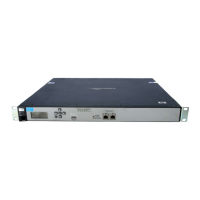Working with VSCs
VSC configuration options
5-11
DTIM count
Specify the DTIM period in the wireless beacon sent by controlled APs. Client stations use
the DTIM to wake up from low-power mode to receive multicast traffic.
APs transmit a beacon every 100 ms. The DTIM counts down with each beacon that is sent.
Therefore if the DTIM is set to 5, then client stations in low-power mode will wake up every
500 ms (.5 second) to receive multicast traffic.
Broadcast name (SSID)
When this option is enabled, controlled APs will broadcast the wireless network name (SSID)
to all client stations. Most wireless adapter cards have a setting that enables them to
automatically discover APs that broadcast their names and connect to the one with the
strongest signal.
If you disable this option, client stations will have to specify the network name you enter for
Name (SSID) when they connect.
Advertise Tx power
When this option is enabled, controlled APs broadcast their current transmit power setting in
the wireless beacon. It also enables support for 802.1h and 802.11d.
Broadcast filtering
Use this option to conserve wireless bandwidth by filtering out non-essential broadcast
traffic. When broadcast filtering is enabled:
DHCP broadcast requests are never forwarded on the wireless port.
DHCP broadcast offers are never forwarded on the wireless port unless the target of the
offer is an associated client on the wireless interface.
ARP broadcast requests are never forwarded out the wireless port unless the target of the
ARP request is an associated client on the wireless interface.
Broadcast filtering should be disabled in the following cases:
An external DHCP server is connected to the wireless network.
If a wireless client bridge is connected to the wireless network.
Band steering
Band steering is used to help solve dense client issues. When band steering is enabled, APs
attempt to move wireless clients that are capable of 802.11a/n onto the 5 GHz band, thus
reducing the load on the slower and more crowded 2.4 GHz band, leaving it for less capable
legacy (802.11b/g) clients.
An AP uses the following methods to encourage a wireless client to associate at 5 GHz
instead of 2.4 GHz.
The AP waits 200ms before responding to the first probe request sent by a client at 2.4
GHz.

